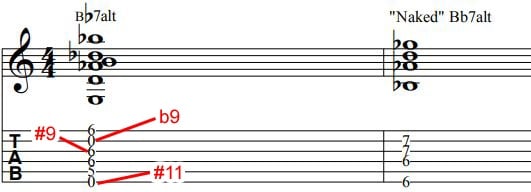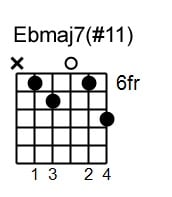Voicings with Open Strings
Aug 23, 2018Hip Chord Shapes You Wouldn't be Able to Reach
The goal of this series is to actually put a lick under your fingers. Here, there’s no more searching for ideas in the sea of jazz theory information. We’ll give stuff you need to play and be creative. in this issue, we will be talking about how you can get some hip chord voicings with open strings.

Original Example
Today’s idea is taken from Misty. Here, we are going to give you some neat chord voicings using open strings to get some fresh sounds.

Check out how we're able to voice this chord in such a unique way and observe where we're playing extensions.
- Bb (root)
- B (b9)
- C# (#9)
- Ab (b7)
- D (3)
- E (#11)
As guitar players, many of the shapes we use are movable. These voicings with open strings are not. However, they help us to access some really cool sounds that we wouldn't otherwise be able to reach. Unless, of course, we have crazy tentacles for fingers. I don't. Do you???
How It Works
Because we are using open strings, we are given access to notes that we wouldn’t otherwise be able to reach. In the example provided, we have a Bb7 with a b9 and a #11. This specific voicing would be really difficult or impossible to reach without the use of open strings. Because of the nature of these voicings, they typically lend themselves to the ends of phrases or tunes.
Download ALL of the licks here: "Voicings with Open Strings"
Join our Community here.
There is just something about the "rattle" of open strings against shapes we are playing that is really special. That's one of the big reasons why cowboy chords are so popular. Yee-haw!
More Examples
Now let’s go over a few different shapes.
Example A
Here is example A. This shape is a nice Am9 voicing. I came up with this one while playing around over “Days of Wine and Roses”, and it’s a nice way to put that G on top while getting a B with the open 2nd string.

Here's a side-by-side for comparison:

I just love that dissonance between the open B string and the C on the 3rd string. It's got a real bite to it!
Example B
Here is Example B. Here is a nice voicing for Gmaj13 omitting the 3rd. The 13th is the open E string and the open G is a nice repeating note at the octave.

Here's a side-by-side for comparison:

Again, the dissonance between the F# in the 4th string and the open G string is really fun. I love dissonances that are tucked into the voicing.
Example C
Here is Example C. In this example, we have a really interesting Ebmaj13(#11). This is a particularly neat arrangement of the neats for this chord as it is using the open 3rd string to play the 3rd of the chord which is G.

Here's a side-by-side for comparison:

Jump In
Ok, now it's your turn! Go ahead and try this over some of your favorite tunes. Remember, because of the nature and density of these chord shapes, they often lend themselves to the ends of phrases and/or tunes, but that's not a hard and fast rule. Try it for yourself and see what works for you!
Download ALL of the licks here: "Voicings with Open Strings"
Join our Community here.









